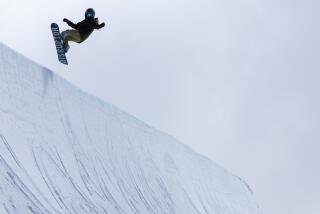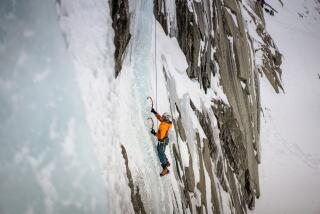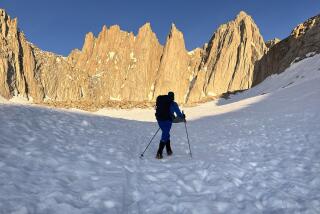Preventing Winter Sports Injuries
A winter getaway to the mountains for skiing, snowshoeing, hiking or sledding seems effortless and simple, not to mention fun. But talk to physicians, emergency medical technicians and ski patrol members who work in local mountain communities and it’s clear: Dangers lurk, and some can kill.
That reality has been demonstrated, tragically, twice in the last month with the skiing deaths of politician/singer Sonny Bono in South Lake Tahoe last week and Michael Kennedy, son of the late Sen. Robert F. Kennedy, in Aspen, Colo., on New Year’s Eve.
Not all accidents are preventable, of course, but health-care providers say many winter mishaps are brought on by lack of preparation, participation above ability level, Southern Californians’ unfamiliarity with winter conditions or a combination of these factors. The day after Christmas, the wait for medical attention in the emergency department of Bear Valley Community Hospital, half a mile from the slopes of Snow Summit Mountain Resort in Big Bear Lake, was at least three hours, said a paramedic. And many waiting for medical attention were tourists participating in winter sports.
Weekend after weekend, Dr. Tina Haller-Wade, a family physician at Frazier Mountain Community Health Center in Frazier Park, north of Los Angeles, sees her share of ailing travelers too. She counted off a recent roster of patients: the sledder who missed the trail and hit a tree; the cross-country skier who fractured a hip; knee problems and ankle sprains from skiing; and countless lacerations. Other injuries included frostbite and concussions from falls.
Preparing for the cold is the first crucial step, Haller-Wade said. If travelers did that, many could spare themselves a trip to the hospital or urgent care clinic. It is not uncommon for weekend visitors to Haller-Wade’s snowy area to come up from L.A. in T-shirts and short-sleeve shirts. “A lot don’t wear gloves,” she said.
Travelers should cover exposed skin to prevent frostbite. Hands and feet, ears and face, especially the tip of the nose, most often are affected
There are other simple measures that can go a long way toward winter sports safety, said Rick Strasser, a member of the ski patrol at Mountain High Ski Resort in Wrightwood and a Barstow firefighter. Eating regularly and nutritiously and staying hydrated is wise, he said. Don’t drink alcoholic beverages and then try to ski or participate in other winter sports.
Paying attention to equipment can minimize the risk of injury, Haller-Wade said. Many travelers, she finds, “don’t check to see what kind of equipment they need.” For example, instead of renting sleds, many use trash can lids to slide down the hills, a practice that invites injury.
Under study is the issue of helmet use while skiing. Last month, a report from the American Medical Assn.’s Council on Scientific Affairs urged helmet use for young skiers but concluded that “there is insufficient data to support the mandatory use of helmets at this time.”
Meanwhile, in the wake of the recent deaths, operators of ski resorts say they are reiterating rules of common sense. “We are referring people to our skier’s responsibility code,” said John McColly, spokesman for Mountain High. Among the guidelines in the code: staying in control at all times, being able to stop to avoid objects or people on the runs, skiing with a friend.
Ski, snowshoe, sled and hike only in areas designated for the activity, Haller-Wade advised. Travelers unfamiliar with an area should stop by the ranger station and pick up maps of local trails.
Not exercising beyond ability level is crucial, Strasser said. He often sees beginners on intermediate slopes. Recently, he rescued a teenager who had attempted a double black diamond (extremely difficult) ski run after his first ski lesson. “He was flying out of control and headed into the trees,” Strasser said. Skiers should ask an instructor to evaluate their abilities, rather than trying to guess what level they are.
If disaster strikes despite good preparation and sensible participation, it pays to know basic first-aid measures.
If a concussion or head injury is suspected, have the injured person lie still, said Terry McDonald, an emergency medical technician at Snow Summit. Moving an injured person can worsen the situation. Request the ski patrol immediately.
If frostbite is suspected, rewarming the injured area is the best treatment. That is best done, especially in severe cases, in a hospital, wilderness experts advise.
For suspected strains and sprains (a stretching, tearing injury of ligaments around a joint), “try to immobilize it,” McDonald said. And follow the other measures in the treatment acronym RICE: rest, immobilization, compression and elevation. If an injury is taken care of properly, the long-term damage may be minimal. But sprains and strains can be difficult to differentiate from a fracture without medical opinion and X-rays.
The Healthy Traveler appears the second and fourth week of every month.
More to Read
Sign up for The Wild
We’ll help you find the best places to hike, bike and run, as well as the perfect silent spots for meditation and yoga.
You may occasionally receive promotional content from the Los Angeles Times.






